Walk into a house and you will know immediately if the furniture reflects the personality of the home-owners, and works for the room. When the furniture is well-chosen there is a feeling of harmony in room, and your eye easily wanders around it.
How do you select furniture and know that it will work for you? Follow these steps and you too will create a room that reflects your individuality and feels right for your home.
Consider the architecture of your room.
If possible, start with an empty space or remove unwanted pieces. Naturally, your wall material and colour, as well as your window furnishings will influence your choice. (Of course if they have not been well chosen, it will be hard to make any furniture look good.)
If there is some strong architectural feature in your room, perhaps you want to work with it, or echo its shape in the furniture, e.g. a curved sofa or half-round table in a bay window, or square-edged furniture symmetrically placed against a geometric brick fireplace.
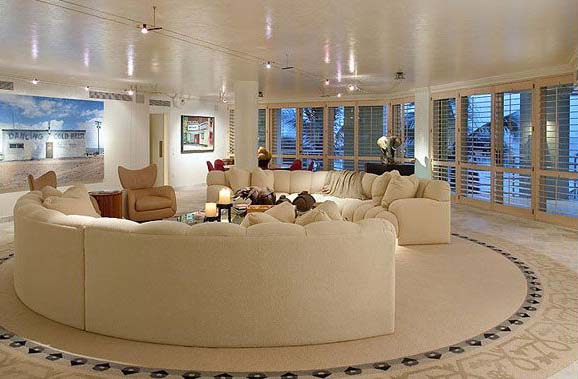
Picture supplied by Freshome.com
Make a floor plan of your furniture.
If you have a lot of furniture to place, create a floor plan and a list of pieces that you think you will need.
Then make a budget an allocate prices to each piece.
What style of furniture do you like?
Your personal preference will dictate the overall style of the furniture i.e. whether Contemporary, Traditional, Period, Country, Beach, Retro, Shabby Chic or Country Specific. (See Furniture Styles) Be wary of themes for they quickly become tiresome.
Once you have chosen your furniture style, search the internet for examples. Often the simpler the furniture, the better it is. A heavily styled piece may loose its appeal, unless it is a real classic.
Ideally, your furniture, like all your decor, should be of a similar style in all rooms, so there is a feeling of fluidity when you move around your home.
Create unity as well as variation with your furniture.
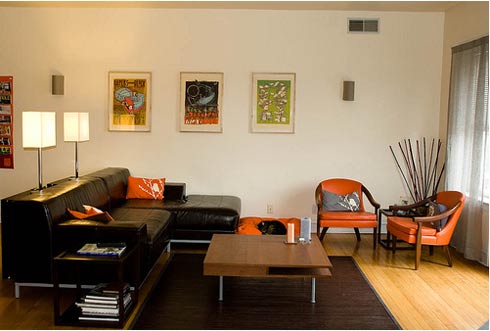
Picture supplied by Freshome.com
Your furniture needs to create a cohesive room, one that has both unity and variation. Both of these qualities come from repeating similar materials, shapes, colours, textures, or patterns. (In the picture above, the similar leather material of the sofa and chair coverings creates the unity; the variation comes from their different shapes.
Whatever you choose needs to relate in some way to other pieces.
Consider the functionality of your furniture.
In a Living Room you need furniture for conversation, casual eating and drinking, as well as watching TV. If you listen to music, you may need a piece close by to store CDs. If you are a reader, you might need a comfortable chair and a light source from a lamp on a table.
Consider the number of people do you want to cater for? You may need a larger number of small chairs to accommodate them.
Think about climate and the comfort of your furniture.
Your chairs naturally need to be comfortable. (Make sure you sit ion them for a while before buying. Some sofas and chairs can have hard, vertical backs.)
If you live in a hot or humid environment, more contemporary furniture that takes up less space and allows airflow around you will feel more comfortable than heavy Traditional furniture. In these situations, leather is the coolest option for sofa covering.
Consider the size of your room
Do you make the room to look bigger or smaller?
A small room generally needs smaller scale furniture (In the picture below furniture is small scale and ‘airy”, which helps to make the room look bigger.)
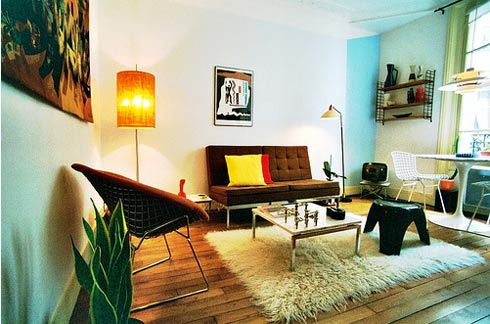
Picture supplied by Freshome.com
However the room must not become cluttered with too many items. A single large piece with a few small secondary items can also make the room look bigger.
Small rooms often need furniture to be multifunctional i.e. a coffee table or bed base that is also a storage area, or a sofa with pillows that becomes a bed. Tables can have extending sections to accommodate the occasional larger numbers.
If you want the room to look bigger, book-shelves and cupboards should be on legs, so you maximize perceived floor space.
When selecting coverings for a small room, use colour very discerningly. Often a variation of one colour will make the area feel bigger. Bold colours on coverings can make a small room look too busy, even claustrophobic.
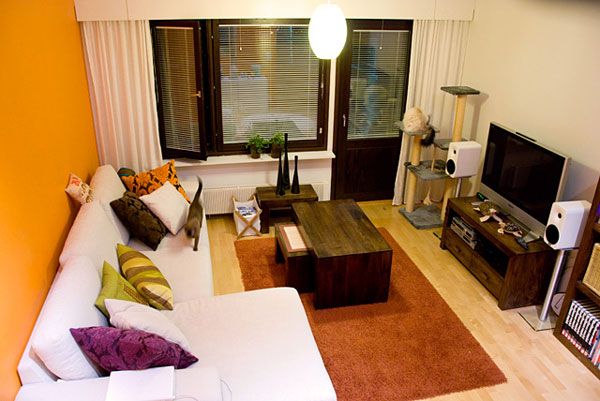
Picture supplied by Freshome.com
In the picture above, if the unit below the TV was white like the sofa, the room would look much bigger.
Shiny materials that reflect light will make a room look bigger. Mirrors that reflect a view through a window or a corridor can have a dramatic effect on a room’s perceived size.
A large room might need dividing into different functional areas or “pods” and require a number of larger items. It will require furniture that appears more solid and with more texture.
A large room will also handle big colour or texture changes.
Choose the shape, textures, patterns and colours.
All of your furniture pieces will have visual ‘weight” according to their shape, colours, pattern and texture Try to balance them so that there is an equal weight on either side of the room, or the weight is dispersed, as in the picture below.. (See the article about Unity and Balance How to Arrange Furniture in a Room)
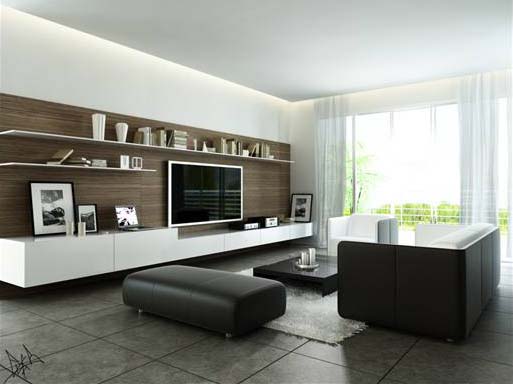
Picture supplied by Home-designing.com
Your personal preference will influence the colours that you choose for coverings and accessories. The colours outside a window to nature will invite similar colours to be used inside. Bolder colours (as well as stronger shapes and patterns) will work with more urban views.
What always works is using variations of one colour, or complimentary muted colours. (See the Colour Wheel). Never in use more than three colours for furnishings and avoid unusual colours like pink, orange and purple.
Whatever the colour of your coverings, they need to be complimentary. Remember that the whiter your walls, the stronger the colour of your furnishing colours will appear.
Selecting the right furniture is not so hard.
Creating an inviting space by selecting the right furniture is not so hard. Take your time, look at rooms you like and analyse them, then go design your furniture setting and trust your judgement.
Related furniture articles
Furniture styles. Well-chosen furniture will create comfortable, ergonomic and visually pleasing interior spaces that reflect your own personality and style. You will naturally gravitate to a certain style of furniture. Once you have your style, you need to be consistent and stick to it...
How to arrange furniture. Follow these steps and your will furniture will appear inviting, comfortable, facilitate conversation and flatter your best pieces...
Polished concrete furniture. Polished concrete furniture can have the same look as marble - and there are many ways to make the finish of your concrete furniture or benchtop unique, as well as long lasting. Today homeowners are turning to polished concrete to enhance the look of their homes - with benches, bench tops, tub surrounds, planters, and more...
